flat tire CADILLAC ESCALADE HYBRID 2011 Owners Manual
[x] Cancel search | Manufacturer: CADILLAC, Model Year: 2011, Model line: ESCALADE HYBRID, Model: CADILLAC ESCALADE HYBRID 2011Pages: 94, PDF Size: 1.83 MB
Page 9 of 94
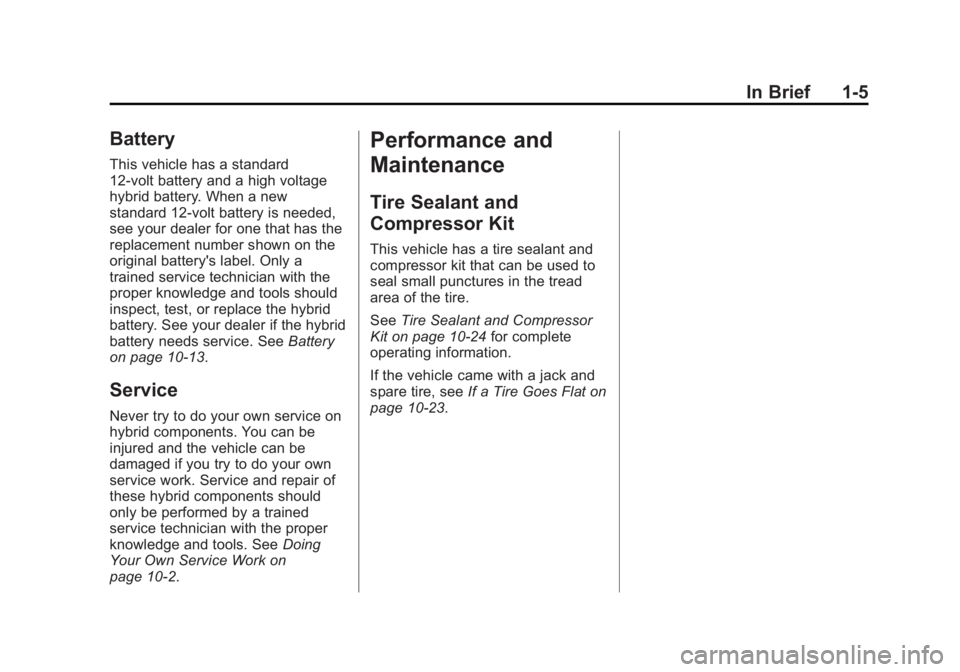
Black plate (5,1)Cadillac Escalade Hybrid - 2011
In Brief 1-5
Battery This vehicle has a standard
12-volt battery and a high voltage
hybrid battery. When a new
standard 12-volt battery is needed,
see your dealer for one that has the
replacement number shown on the
original battery's label. Only a
trained service technician with the
proper knowledge and tools should
inspect, test, or replace the hybrid
battery. See your dealer if the hybrid
battery needs service. See Battery
on page 10 ‑ 13 .
Service Never try to do your own service on
hybrid components. You can be
injured and the vehicle can be
damaged if you try to do your own
service work. Service and repair of
these hybrid components should
only be performed by a trained
service technician with the proper
knowledge and tools. See Doing
Your Own Service Work on
page 10 ‑ 2 . Performance and
Maintenance Tire Sealant and
Compressor Kit This vehicle has a tire sealant and
compressor kit that can be used to
seal small punctures in the tread
area of the tire.
See Tire Sealant and Compressor
Kit on page 10 ‑ 24 for complete
operating information.
If the vehicle came with a jack and
spare tire, see If a Tire Goes Flat on
page 10 ‑ 23 .
Page 45 of 94

Black plate (1,1)Cadillac Escalade Hybrid - 2011
Vehicle Care 10-1
Vehicle Care Vehicle Checks Doing Your Own
Service Work . . . . . . . . . . . . . . . 10-2
Engine Compartment
Overview . . . . . . . . . . . . . . . . . . . 10-4
Automatic Transmission
Fluid . . . . . . . . . . . . . . . . . . . . . . . 10-6
Drive Motor/Generator Control
Module (DMCM) Coolant
Surge Tank
Pressure Cap . . . . . . . . . . . . . . 10-9
Drive Motor/Generator Control
Module (DMCM) Cooling
System . . . . . . . . . . . . . . . . . . . . . 10-9
Power Steering Fluid . . . . . . . 10-13
Battery . . . . . . . . . . . . . . . . . . . . . 10-13
Four-Wheel Drive . . . . . . . . . . . 10-14
Electrical System High Voltage Devices and
Wiring . . . . . . . . . . . . . . . . . . . . . 10-15
Fuses and Circuit
Breakers . . . . . . . . . . . . . . . . . . 10-15
Engine Compartment Fuse
Block . . . . . . . . . . . . . . . . . . . . . 10-15 Wheels and Tires Tire Pressure . . . . . . . . . . . . . . . 10-17
Tire Pressure Monitor
Operation . . . . . . . . . . . . . . . . . 10-18
Tire Rotation . . . . . . . . . . . . . . . 10-22
If a Tire Goes Flat . . . . . . . . . . 10-23
Tire Sealant and
Compressor Kit . . . . . . . . . . . 10-24
Storing the Tire Sealant and
Compressor Kit . . . . . . . . . . . 10-31
Jump Starting Jump Starting . . . . . . . . . . . . . . 10-31
Towing Recreational Vehicle
Towing . . . . . . . . . . . . . . . . . . . . 10-36
Appearance Care Exterior Care . . . . . . . . . . . . . . . 10-40
Page 61 of 94
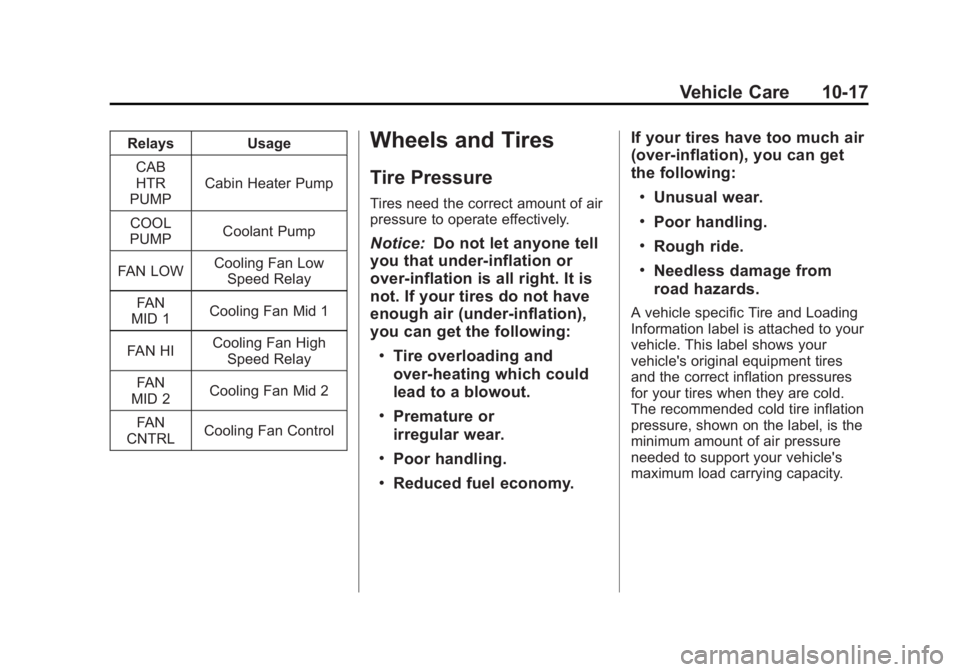
Black plate (17,1)Cadillac Escalade Hybrid - 2011
Vehicle Care 10-17Relays Usage
CAB
HTR
PUMP Cabin Heater Pump
COOL
PUMP Coolant Pump
FAN LOW Cooling Fan Low
Speed Relay
FAN
MID 1 Cooling Fan Mid 1
FAN HI Cooling Fan High
Speed Relay
FAN
MID 2 Cooling Fan Mid 2
FAN
CNTRL Cooling Fan Control Wheels and Tires Tire Pressure Tires need the correct amount of air
pressure to operate effectively.
Notice: Do not let anyone tell
you that under ‐ inflation or
over ‐ inflation is all right. It is
not. If your tires do not have
enough air (under ‐ inflation),
you can get the following: .
Tire overloading and
over-heating which could
lead to a blowout. .
Premature or
irregular wear. .
Poor handling. .
Reduced fuel economy. If your tires have too much air
(over ‐ inflation), you can get
the following: .
Unusual wear. .
Poor handling. .
Rough ride. .
Needless damage from
road hazards. A vehicle specific Tire and Loading
Information label is attached to your
vehicle. This label shows your
vehicle's original equipment tires
and the correct inflation pressures
for your tires when they are cold.
The recommended cold tire inflation
pressure, shown on the label, is the
minimum amount of air pressure
needed to support your vehicle's
maximum load carrying capacity.
Page 62 of 94

Black plate (18,1)Cadillac Escalade Hybrid - 2011
10-18 Vehicle Care For additional information regarding
how much weight your vehicle can
carry, and an example of the Tire
and Loading Information label, see
“ Vehicle Load Limits ” in the owner
manual. How you load your vehicle
affects vehicle handling and ride
comfort. Never load your vehicle
with more weight than it was
designed to carry.
When to Check Check your tires once a month
or more.
How to Check Use a good quality pocket-type
gauge to check tire pressure. You
cannot tell if your tires are properly
inflated simply by looking at them.
Radial tires may look properly
inflated even when they're
underinflated. Check the tire's
inflation pressure when the tires are
cold. Cold means your vehicle has
been sitting for at least three hours
or driven no more than 1.6 km
(1 mile). Remove the valve cap from the tire
valve stem. Press the tire gauge
firmly onto the valve to get a
pressure measurement. If the cold
tire inflation pressure matches the
recommended pressure on the tire
and loading information label, no
further adjustment is necessary.
If the pressure is low, add air until
you reach the recommended
amount.
If you overfill the tire, release air by
pushing on the metal stem in the
center of the tire valve. Recheck the
tire pressure with the tire gauge.
Be sure to put the valve caps back
on the valve stems. They help
prevent leaks by keeping out dirt
and moisture. Tire Pressure Monitor
Operation This vehicle may have a Tire
Pressure Monitor System (TPMS).
The TPMS is designed to warn the
driver when a low tire pressure
condition exists. TPMS sensors are
mounted onto each tire and wheel
assembly. The TPMS sensors
monitor the air pressure in the
vehicle's tires and transmit the tire
pressure readings to a receiver
located in the vehicle.
Page 63 of 94
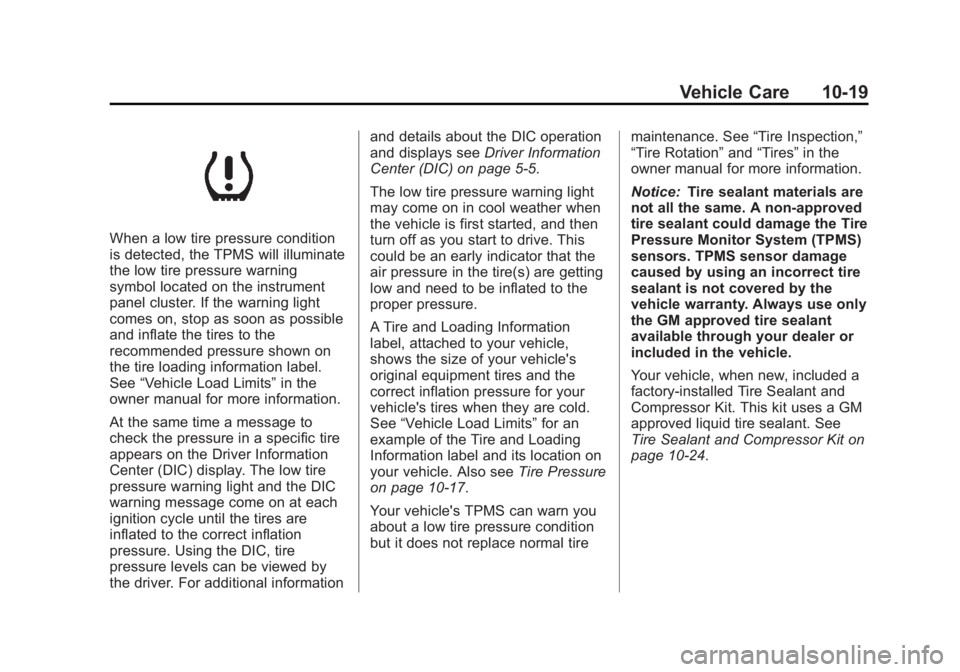
Black plate (19,1)Cadillac Escalade Hybrid - 2011
Vehicle Care 10-19
When a low tire pressure condition
is detected, the TPMS will illuminate
the low tire pressure warning
symbol located on the instrument
panel cluster. If the warning light
comes on, stop as soon as possible
and inflate the tires to the
recommended pressure shown on
the tire loading information label.
See “ Vehicle Load Limits ” in the
owner manual for more information.
At the same time a message to
check the pressure in a specific tire
appears on the Driver Information
Center (DIC) display. The low tire
pressure warning light and the DIC
warning message come on at each
ignition cycle until the tires are
inflated to the correct inflation
pressure. Using the DIC, tire
pressure levels can be viewed by
the driver. For additional information and details about the DIC operation
and displays see Driver Information
Center (DIC) on page 5 ‑ 5 .
The low tire pressure warning light
may come on in cool weather when
the vehicle is first started, and then
turn off as you start to drive. This
could be an early indicator that the
air pressure in the tire(s) are getting
low and need to be inflated to the
proper pressure.
A Tire and Loading Information
label, attached to your vehicle,
shows the size of your vehicle's
original equipment tires and the
correct inflation pressure for your
vehicle's tires when they are cold.
See “ Vehicle Load Limits ” for an
example of the Tire and Loading
Information label and its location on
your vehicle. Also see Tire Pressure
on page 10 ‑ 17 .
Your vehicle's TPMS can warn you
about a low tire pressure condition
but it does not replace normal tire maintenance. See “ Tire Inspection, ”
“ Tire Rotation ” and “ Tires ” in the
owner manual for more information.
Notice: Tire sealant materials are
not all the same. A non-approved
tire sealant could damage the Tire
Pressure Monitor System (TPMS)
sensors. TPMS sensor damage
caused by using an incorrect tire
sealant is not covered by the
vehicle warranty. Always use only
the GM approved tire sealant
available through your dealer or
included in the vehicle.
Your vehicle, when new, included a
factory ‐ installed Tire Sealant and
Compressor Kit. This kit uses a GM
approved liquid tire sealant. See
Tire Sealant and Compressor Kit on
page 10 ‑ 24 .
Page 65 of 94
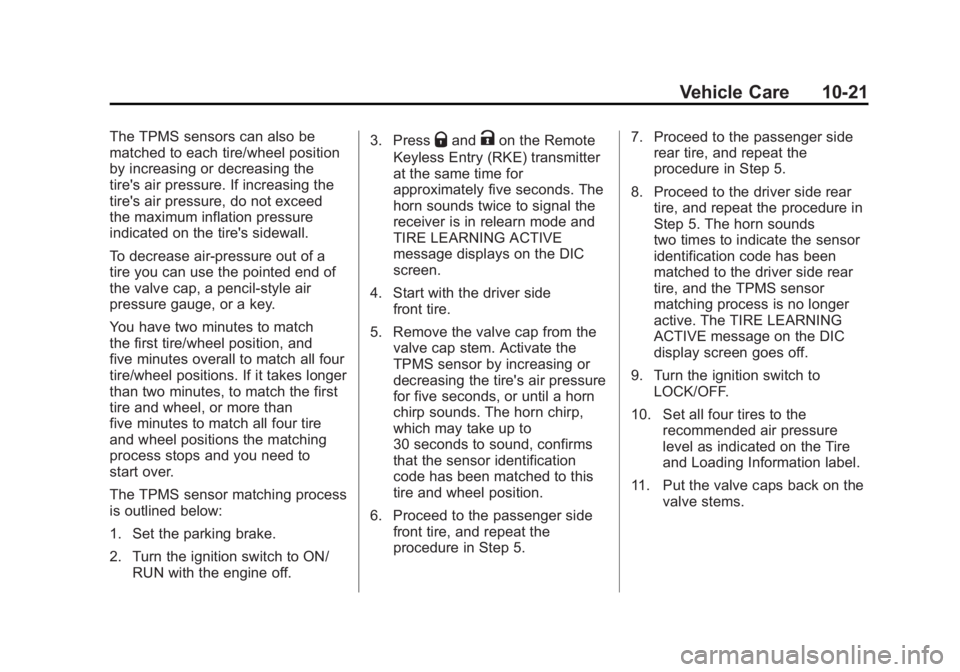
Black plate (21,1)Cadillac Escalade Hybrid - 2011
Vehicle Care 10-21The TPMS sensors can also be
matched to each tire/wheel position
by increasing or decreasing the
tire's air pressure. If increasing the
tire's air pressure, do not exceed
the maximum inflation pressure
indicated on the tire's sidewall.
To decrease air-pressure out of a
tire you can use the pointed end of
the valve cap, a pencil-style air
pressure gauge, or a key.
You have two minutes to match
the first tire/wheel position, and
five minutes overall to match all four
tire/wheel positions. If it takes longer
than two minutes, to match the first
tire and wheel, or more than
five minutes to match all four tire
and wheel positions the matching
process stops and you need to
start over.
The TPMS sensor matching process
is outlined below:
1. Set the parking brake.
2. Turn the ignition switch to ON/
RUN with the engine off. 3. Press
Q and
K on the Remote
Keyless Entry (RKE) transmitter
at the same time for
approximately five seconds. The
horn sounds twice to signal the
receiver is in relearn mode and
TIRE LEARNING ACTIVE
message displays on the DIC
screen.
4. Start with the driver side
front tire.
5. Remove the valve cap from the
valve cap stem. Activate the
TPMS sensor by increasing or
decreasing the tire's air pressure
for five seconds, or until a horn
chirp sounds. The horn chirp,
which may take up to
30 seconds to sound, confirms
that the sensor identification
code has been matched to this
tire and wheel position.
6. Proceed to the passenger side
front tire, and repeat the
procedure in Step 5. 7. Proceed to the passenger side
rear tire, and repeat the
procedure in Step 5.
8. Proceed to the driver side rear
tire, and repeat the procedure in
Step 5. The horn sounds
two times to indicate the sensor
identification code has been
matched to the driver side rear
tire, and the TPMS sensor
matching process is no longer
active. The TIRE LEARNING
ACTIVE message on the DIC
display screen goes off.
9. Turn the ignition switch to
LOCK/OFF.
10. Set all four tires to the
recommended air pressure
level as indicated on the Tire
and Loading Information label.
11. Put the valve caps back on the
valve stems.
Page 66 of 94
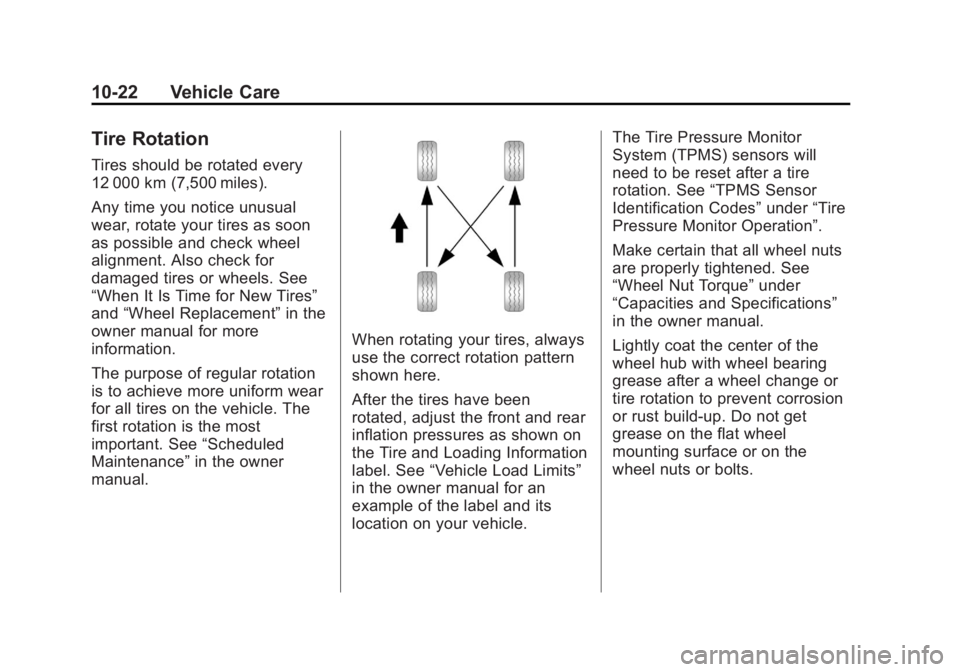
Black plate (22,1)Cadillac Escalade Hybrid - 2011
10-22 Vehicle Care
Tire Rotation Tires should be rotated every
12 000 km (7,500 miles).
Any time you notice unusual
wear, rotate your tires as soon
as possible and check wheel
alignment. Also check for
damaged tires or wheels. See
“ When It Is Time for New Tires ”
and “ Wheel Replacement ” in the
owner manual for more
information.
The purpose of regular rotation
is to achieve more uniform wear
for all tires on the vehicle. The
first rotation is the most
important. See “ Scheduled
Maintenance ” in the owner
manual. When rotating your tires, always
use the correct rotation pattern
shown here.
After the tires have been
rotated, adjust the front and rear
inflation pressures as shown on
the Tire and Loading Information
label. See “ Vehicle Load Limits ”
in the owner manual for an
example of the label and its
location on your vehicle. The Tire Pressure Monitor
System (TPMS) sensors will
need to be reset after a tire
rotation. See “ TPMS Sensor
Identification Codes ” under “ Tire
Pressure Monitor Operation ” .
Make certain that all wheel nuts
are properly tightened. See
“ Wheel Nut Torque ” under
“ Capacities and Specifications ”
in the owner manual.
Lightly coat the center of the
wheel hub with wheel bearing
grease after a wheel change or
tire rotation to prevent corrosion
or rust build-up. Do not get
grease on the flat wheel
mounting surface or on the
wheel nuts or bolts.
Page 67 of 94
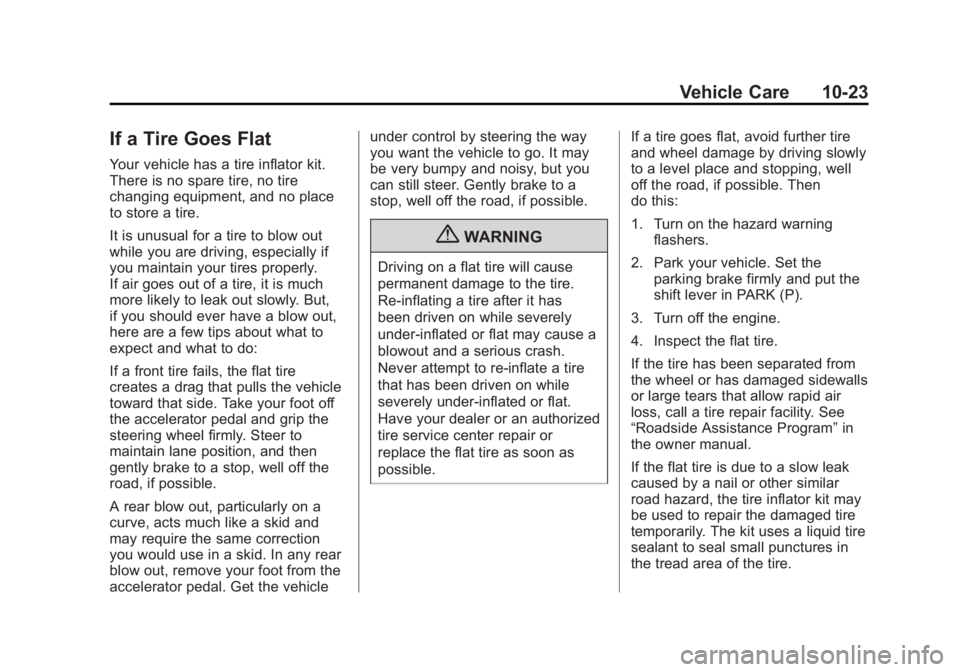
Black plate (23,1)Cadillac Escalade Hybrid - 2011
Vehicle Care 10-23
If a Tire Goes Flat Your vehicle has a tire inflator kit.
There is no spare tire, no tire
changing equipment, and no place
to store a tire.
It is unusual for a tire to blow out
while you are driving, especially if
you maintain your tires properly.
If air goes out of a tire, it is much
more likely to leak out slowly. But,
if you should ever have a blow out,
here are a few tips about what to
expect and what to do:
If a front tire fails, the flat tire
creates a drag that pulls the vehicle
toward that side. Take your foot off
the accelerator pedal and grip the
steering wheel firmly. Steer to
maintain lane position, and then
gently brake to a stop, well off the
road, if possible.
A rear blow out, particularly on a
curve, acts much like a skid and
may require the same correction
you would use in a skid. In any rear
blow out, remove your foot from the
accelerator pedal. Get the vehicle under control by steering the way
you want the vehicle to go. It may
be very bumpy and noisy, but you
can still steer. Gently brake to a
stop, well off the road, if possible.
{ WARNINGDriving on a flat tire will cause
permanent damage to the tire.
Re-inflating a tire after it has
been driven on while severely
under-inflated or flat may cause a
blowout and a serious crash.
Never attempt to re-inflate a tire
that has been driven on while
severely under-inflated or flat.
Have your dealer or an authorized
tire service center repair or
replace the flat tire as soon as
possible. If a tire goes flat, avoid further tire
and wheel damage by driving slowly
to a level place and stopping, well
off the road, if possible. Then
do this:
1. Turn on the hazard warning
flashers.
2. Park your vehicle. Set the
parking brake firmly and put the
shift lever in PARK (P).
3. Turn off the engine.
4. Inspect the flat tire.
If the tire has been separated from
the wheel or has damaged sidewalls
or large tears that allow rapid air
loss, call a tire repair facility. See
“ Roadside Assistance Program ” in
the owner manual.
If the flat tire is due to a slow leak
caused by a nail or other similar
road hazard, the tire inflator kit may
be used to repair the damaged tire
temporarily. The kit uses a liquid tire
sealant to seal small punctures in
the tread area of the tire.
Page 68 of 94
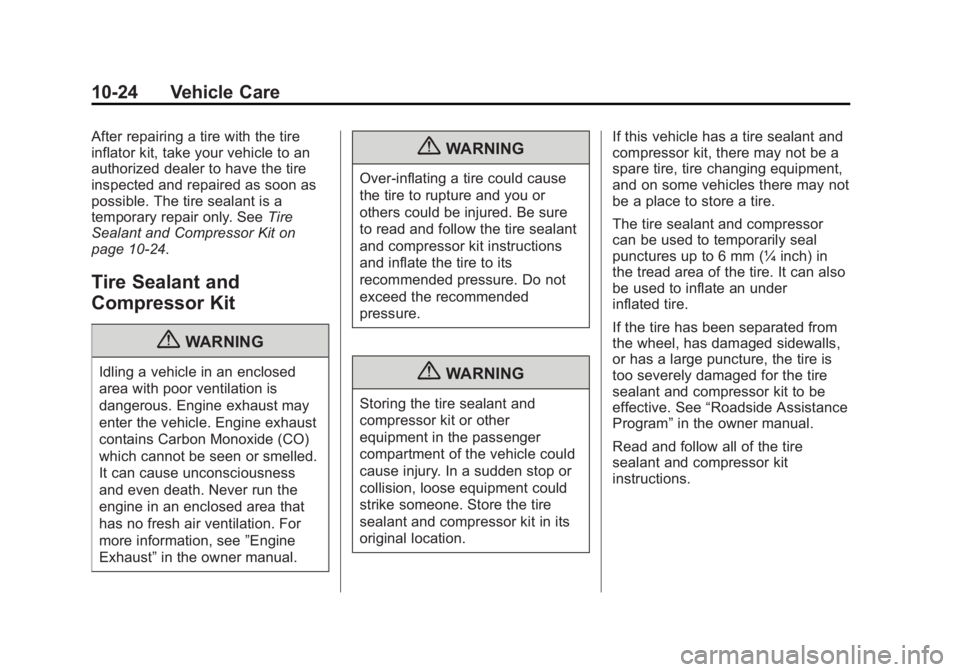
Black plate (24,1)Cadillac Escalade Hybrid - 2011
10-24 Vehicle Care After repairing a tire with the tire
inflator kit, take your vehicle to an
authorized dealer to have the tire
inspected and repaired as soon as
possible. The tire sealant is a
temporary repair only. See Tire
Sealant and Compressor Kit on
page 10 ‑ 24 .
Tire Sealant and
Compressor Kit
{ WARNINGIdling a vehicle in an enclosed
area with poor ventilation is
dangerous. Engine exhaust may
enter the vehicle. Engine exhaust
contains Carbon Monoxide (CO)
which cannot be seen or smelled.
It can cause unconsciousness
and even death. Never run the
engine in an enclosed area that
has no fresh air ventilation. For
more information, see ” Engine
Exhaust ” in the owner manual. { WARNINGOver-inflating a tire could cause
the tire to rupture and you or
others could be injured. Be sure
to read and follow the tire sealant
and compressor kit instructions
and inflate the tire to its
recommended pressure. Do not
exceed the recommended
pressure.
{ WARNINGStoring the tire sealant and
compressor kit or other
equipment in the passenger
compartment of the vehicle could
cause injury. In a sudden stop or
collision, loose equipment could
strike someone. Store the tire
sealant and compressor kit in its
original location. If this vehicle has a tire sealant and
compressor kit, there may not be a
spare tire, tire changing equipment,
and on some vehicles there may not
be a place to store a tire.
The tire sealant and compressor
can be used to temporarily seal
punctures up to 6 mm (¼ inch) in
the tread area of the tire. It can also
be used to inflate an under
inflated tire.
If the tire has been separated from
the wheel, has damaged sidewalls,
or has a large puncture, the tire is
too severely damaged for the tire
sealant and compressor kit to be
effective. See “ Roadside Assistance
Program ” in the owner manual.
Read and follow all of the tire
sealant and compressor kit
instructions.
Page 69 of 94
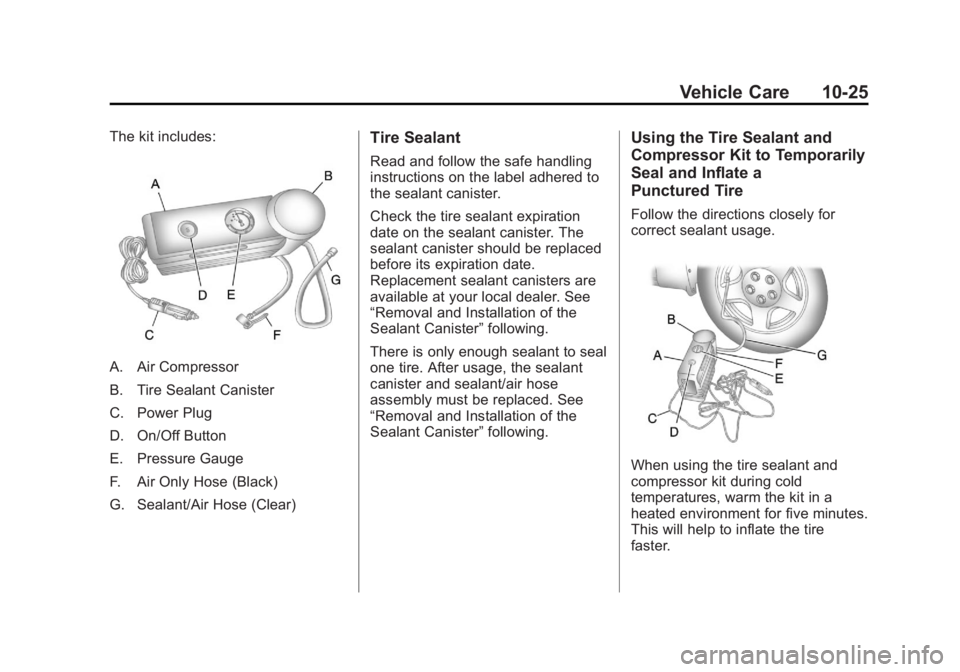
Black plate (25,1)Cadillac Escalade Hybrid - 2011
Vehicle Care 10-25The kit includes:
A. Air Compressor
B. Tire Sealant Canister
C. Power Plug
D. On/Off Button
E. Pressure Gauge
F. Air Only Hose (Black)
G. Sealant/Air Hose (Clear) Tire Sealant Read and follow the safe handling
instructions on the label adhered to
the sealant canister.
Check the tire sealant expiration
date on the sealant canister. The
sealant canister should be replaced
before its expiration date.
Replacement sealant canisters are
available at your local dealer. See
“ Removal and Installation of the
Sealant Canister ” following.
There is only enough sealant to seal
one tire. After usage, the sealant
canister and sealant/air hose
assembly must be replaced. See
“ Removal and Installation of the
Sealant Canister ” following. Using the Tire Sealant and
Compressor Kit to Temporarily
Seal and Inflate a
Punctured Tire Follow the directions closely for
correct sealant usage.
When using the tire sealant and
compressor kit during cold
temperatures, warm the kit in a
heated environment for five minutes.
This will help to inflate the tire
faster.